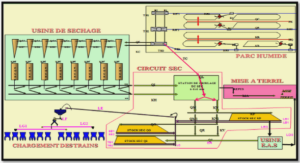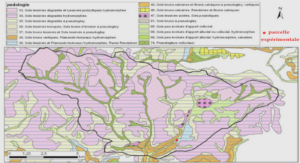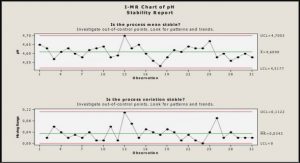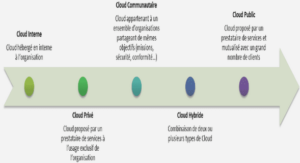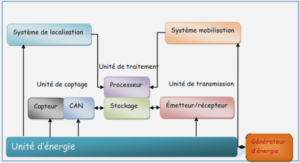Télécharger le fichier pdf d’un mémoire de fin d’études
MULTI-STATE PHYSICS MODEL (MSPM) FRAMEWORK FOR COMPONENT RELIAIBLITY ASSESSMENT INCLUDING SEMI-MARKOV AND RANDOM SHOCK PROCESSES
MSPM framework is proposed by Unwin et al. [19] for modeling nuclear component degradation, also accounting for the effects of environmental factors (e.g. temperature and stress) within certain predetermined ranges [63]. Random shocks need to be accounted for on top of the underlying degradation processes because they can bring variations to influencing environmental factors, even outside their predetermined boundaries [64] that can accelerate the degradation processes. For example, thermal, and mechanical shocks (e.g. internal thermal shocks and water hammers) [30, 31] onto power plant components can lead to intense increases in temperatures, and stresses, respectively; under these extreme conditions, the original physics functions in MSPM might be insufficient to characterize the influences of random shocks onto the degradation processes, and must, therefore, be modified. In this Chapter, we extend the MSPM framework for component reliability assessment by including semi-Markov and random shock processes, where the probability of a random shock resulting in extreme or cumulative shock, and the cumulative damages, are both s-dependent on the current component degradation condition.
Extended MSPM framework
A continuous-time stochastic process is called a semi-Markov process if the embedded jump chain is a Markov Chain and the times between transitions may be random variables with any distribution [65]. It more generally describes the fact that the time of transition to a state can depend on the residence time in the current state, and hence is more suitable for including maintenance [66]. The following assumptions are made for the extended MSPM framework based on semi-Markov processes:
• The degradation process has a finite number of states = {0,1, … , } where states 0, and M represent the complete failure state, and perfect functioning state, respectively. The generic intermediate degradation states i (0<i<M) are established according to the degradation development and condition, wherein the component is functioning or partially functioning.
• The degradation follows a continuous-time semi-Markov process; the transition rate between state i and state j, denoted by « #,$ %#, & , is a function of %# which is the residence time of the component being in the current state i since the last transition, and & which represents the external influencing factors (including physical factors).
• The initial state (at time t = 0) of the component is M.
• Maintenance can be carried out from any degradation state, except for the complete failure state (in other words, there is no repair from failure).
Fig. 2-1 presents the diagram of the semi-Markov component degradation process.
The solution to the semi-Markov process model is the state probability vector ( = { 8 , 83 , … , 2 }. Because no maintenance is carried out from the component failure state, and the component is regarded as functioning in all other intermediate alternative states.
Analytically solving the continuous time semi-Markov model with state residence time-dependent transition rates is a difficult or sometimes impossible task, and the Monte Carlo simulation method is usually applied to obtain ( [68, 69].
Generalized random shock models
The following assumptions are made on the random shock process.
• The arrivals of random shocks follow a homogeneous Poisson process {9 , ≥ 0} [32] with constant arrival rate ;. The random shocks are s-independent of the degradation process, but they can influence the degradation process (see Fig. 2-2).
• The damages of random shocks are divided into two types: extreme, and cumulative.
• Extreme shock and cumulative shock are mutually exclusive.
• The component fails immediately upon occurrence of extreme shocks.
• The probability of a random shock resulting in extreme or cumulative damage is s-dependent on the current component degradation.
• The damage of cumulative shocks can only influence the degradation transition departing from the current state, and its impact on the degradation process is s-dependent on the current component degradation.
The first five assumptions are taken from [20]. The sixth assumption reflects the aging effects addressed in Fan et al.’s shock model [39], where the random shocks are more fatal to the component (i.e. more likely lead to extreme damages) when the component is in severe degradation states. However, the influences of cumulative shocks under aging effects have not been considered in Fan et al.’s model. In addition, the random shock damage is assumed to depend on the current degradation, characterized by three parameters: 1) the current degradation state i, 2) the number of cumulative shocks m that occurred while in the current degradation state since the last degradation state transition, and 3) the residence time %#,< of the component in the current degradation state i after m cumulative shocks %#,< ≥0.
Proposed modeling framework
Based on the first and second assumptions on random shocks, the new model that integrates random shocks into MSPM is shown in Fig 2-3. In the model, the states of the component are represented by pair (i,m), where i is the degradation state, and m is the number of cumulative shocks that occurred during the residence time in the current state. For all the degradation states of the component except for state 0, the number of cumulative shocks could range from 0 to positive infinity. If the transition to a new degradation state occurs, the number of cumulative shocks is set to 0, coherently with the last assumption on random shocks. The state space of the new integrated model is denoted by ′={ , 0 , , 1 , ,2 ,…, − 1,0 , − 1,1 , … , 0,0 }. The component is failed whenever the model reaches (0,0). The transition rate denoted by » #, , $, =%#,< , &> is residence time-dependent, thus rendering the process a continuous time semi-Markov process.
The first two types eqs. (2.3) and (2.4) depend on the probability of a random shock resulting in extreme damage, and in cumulative damage, respectively; the last type of transition rates eq. (2.5) depends on the cumulative damage of random shocks. In this model, we do not directly associate a failure threshold to the cumulative shocks, because the damage of cumulative shocks can only influence the degradation transition departing from the current state, and its impact on the degradation process is s-dependent on the current component degradation. The cumulative shocks can only aggravate the degradation condition of the component instead of leading it suddenly to failure (which is the role of extreme shocks). The effect of the cumulative shocks is reflected in the change of transition rates. The probability of a shock becoming an extreme one depends on the degradation condition of the component. The extreme shocks immediately lead the component to failure, whereas the damage of cumulative shocks accelerates the degradation processes of the component.
The proposed model is based on a semi-Markov process and random shocks. Under this general structure, as explained in the paragraph above, the physics lies in the transition rates of the semi-Markov process. We refer to it as a physics model because the stressors (e.g. the crack in the case study) that cause the component degradation are explicitly modeled, differently from the conventional way of estimating the transition rates from historical failure and degradation data, which are relatively rare for the critical components. More information about MSPM can be found in [9]. In addition, the random shocks are integrated into the MSPM in a way that they may change the physics functions of the transition rates, within a general formulation.
|
Table des matières
1. INTRODUCTION
1.1 Background
1.2 Degradation modeling
1.3 Factors considered in degradation modeling
1.3.1 Degradation dependency
1.3.2 Random shocks
1.3.3 Maintenance policy
1.4 Research objectives
1.5 Structure of the thesis
2. MULTI-STATE PHYSICS MODEL (MSPM) FRAMEWORK FOR COMPONENT RELIAIBLITY ASSESSMENT INCLUDING SEMI-MARKOV AND RANDOM SHOCK PROCESSES
2.1 Extended MSPM framework
2.2 Generalized random shock models
2.3 Proposed modeling framework
2.4 Component reliability estimation method
2.4.1 Basics of Monte Carlo simulation
2.4.2 The simulation procedure
3. DYNAMIC RELIABILITY MODELS FOR SYSTEMS WITH DEGRADATION DEPENDENCY
3.1 Degradation models
3.1.1 Physics-based models (PBMs)
3.1.2 Multi-state models (MSMs)
3.2 Degradation model of the system considering dependency
3.3 System reliability estimation method
4. SYSTEMS RELIABILITY ASSESSMENT CONSIDERING DEGRADATION DEPENDENCY AND EPISTEMIC UNCERTAINTY
4.1 State of the art
4.2 Piecewise-deterministic Markov process (PDMP) modeling framework under epistemic uncertainty
4.3 Solution methodology
4.3.1 Finite-volume (FV) for solving PDMP
4.3.2 Quantification of fuzzy system reliability
5. IMPORTANCE MEASURES (IMS) FOR COMPONENTS WITH DEGRADATION DEPENDENCY AND SUBJECT TO MAINTENANCE
5.1 State of the art
5.2 PDMP modeling framework considering maintenance
5.3 Component IMs
5.4 Quantification of Component IMs
6. MAINTENANCE OPTIMIZATION FOR SYSTEMS CONSDERING EPISTEMIC UNCERTAINTY AND DEGRADATION DEPENDENCY
6.1 Maintenance policy
6.2 Maintenance optimization under uncertainty
6.2.1 Maintenance optimization objective function
6.2.2 Epistemic uncertainty
6.2.3 Optimization problem definition
6.3 Solution methodology
6.3.1 FV method
6.3.2 DE approach
6.3.3 NSDE
6.3.4 Integration of methods
7. RELIABILITY ASSESSMENT OF SYSTEMS SUBJECT TO DEPENDENT DEGRADATION PROCESSESA DN RANDOM SHOCKS
7.1 Dependency between degradation processes and random shocks
7.1.1 Impacts on MSMs
7.1.2 Impacts on PBMs
7.2 PDMP modeling framework for systems subject to degradation dependency and random shocks
7.3 Solution methodology
7.3.1 MC simulation method
7.3.2 FV method
8. RELIABILITY ASSESSMENT METHOD FOR SYSTEMS WITH A LARGE NUMBER OF COMPONENTS CONSIDERING DEGRADATION DEPENDENCY
8.1 Methodology
8.1.1 Binary decision diagrams (BDDs)
8.1.2 MC simulation method
8.1.3 Flowchart of the proposed method
9. APPLICATIONS
9.1 Single components
9.1.1 Reliability assessment of a dissimilar metal weld in a primary coolant system
9.2 Multi-component systems (with a limited number of components)
9.2.1 Subsystem of the residual heat removal system (RHRS)
9.3 Multi-component systems (with a large number of components)
9.3.1 Reliability assessment of one branch of the residual heat removal system
10. CONCLUSIONS
10.1 Original contributions
10.2 Future research
REFERENCES
APPENDED PAPERS
Télécharger le rapport complet

